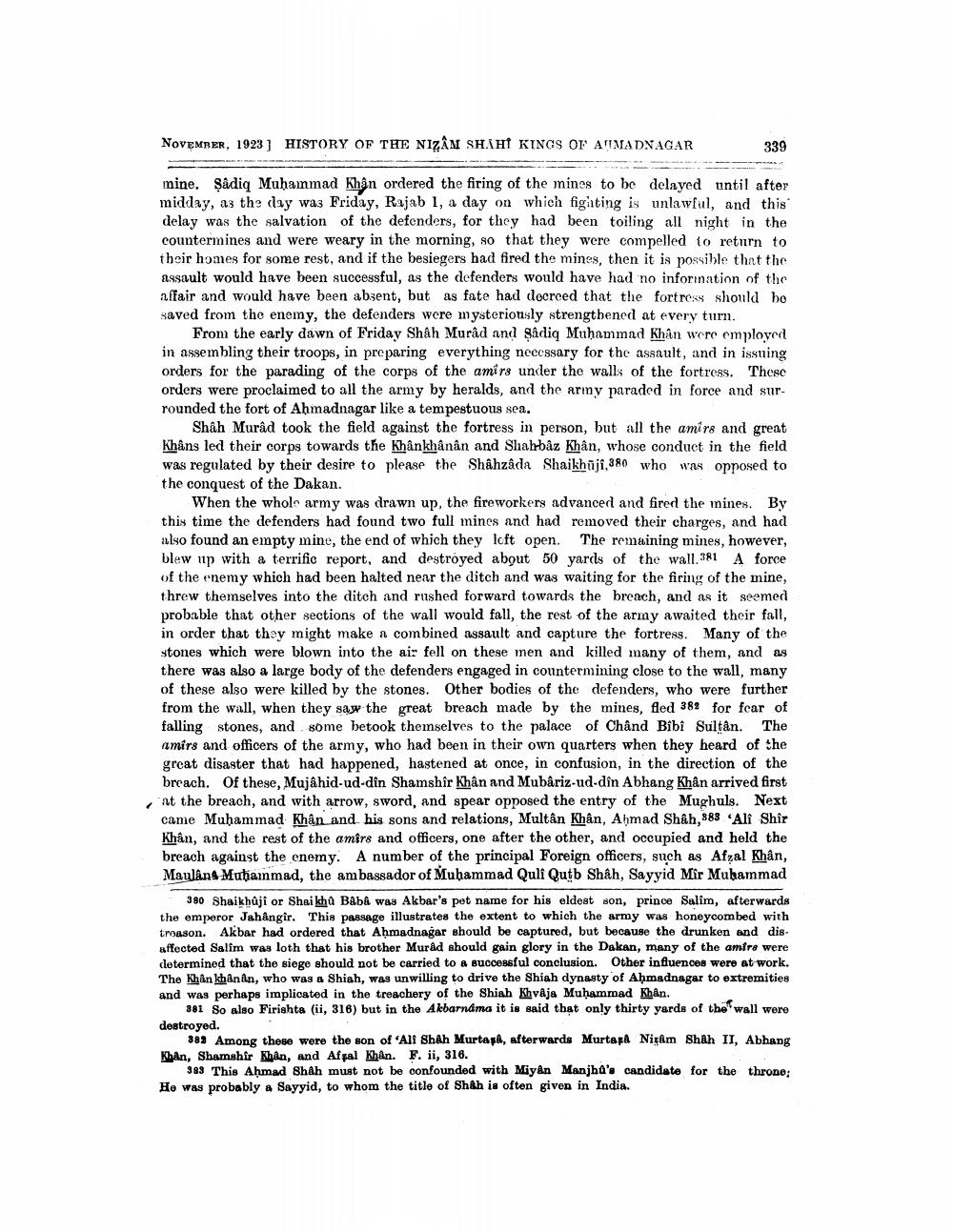________________
NOVEMBER, 1923] HISTORY OF THE NIZAM SHAH KINGS OF ANIMADNAGAR
339
mine. Sadiq Muhammad Khân ordered the firing of the mines to be delayed until after midday, as the clay was Friday, Rajab 1, a day on which fighting is unlawful, and this delay was the salvation of the defenders, for they had been toiling all night in the countermines and were weary in the morning, so that they were compelled to return to their homes for some rest, and if the besiegers had fired the mines, then it is possible that the assault would have been successful, as the defenders would have had no inforination of the affair and would have been absent, but as fate had decreed that the fortress should be Haved from the enemy, the defenders were mysteriously strengthened at every turn.
From the early dawn of Friday Shah Murâd and sadiq Muhammad Khan were employed in assembling their troops, in preparing everything necessary for the assault, and in issuing orders for the parading of the corps of the amirs under the walls of the fortress. These orders were proclaimed to all the army by heralds, and the army paraded in force and surrounded the fort of Ahmadnagar like a tempestuous sea.
Shah Murad took the field against the fortress in person, but all the amirs and great Khâns led their corps towards the khânkhânån and Shahbaz Khân, whose conduct in the field was regulated by their desire to please the Shahzada Shaikhūjî,380 who was opposed to the conquest of the Dakan.
When the whole army was drawn up, the fireworkers advanced and fired the mines. By this time the defenders had found two full mines and had removed their charges, and had also found an empty mine, the end of which they left open. The remaining mines, however, blew up with a terrific report, and destroyed about 50 yards of the wall.381 A force of the enemy which had been halted near the ditch and was waiting for the firing of the mine, threw themselves into the ditch and rushed forward towards the breach, and as it seemed probable that other sections of the wall would fall, the rest of the army awaited their fall, in order that they might make a combined assault and capture the fortress. Many of the stones which were blown into the air fell on these men and killed many of them, and as there was also a large body of the defenders engaged in countermining close to the wall, many of these also were killed by the stones. Other bodies of the defenders, who were further from the wall, when they saw the great breach made by the mines, fled 382 for fear of falling stones, and some betook themselves to the palace of Chånd Bibi Sultan. The amirs and officers of the army, who had been in their own quarters when they heard of the great disaster that had happened, hastened at once, in confusion, in the direction of the breach. Of these, Mujahid-ud-din Shamshir Khân and Mubariz-ud-din Abhang Khan arrived first at the breach, and with arrow, sword, and spear opposed the entry of the Mughuls. Next came Muhammad Khan and his sons and relations, Multân Khân, Ahmad Shah,883 Ali Shîr Khân, and the rest of the amirs and officers, one after the other, and occupied and held the breach against the enemy. A number of the principal Foreign officers, such as Afzal Khân, Maulana Muhammad, the ambassador of Muhammad Quli Qutb Shah, Sayyid Mir Muhammad
380 Shaikhûji or Shaikh a BABA was Akbar's pet name for his eldest son, prince Salim, afterwards the emperor Jahangir. This passage illustrates the extent to which the army was honeycombed with troason. Akbar had ordered that Ahmadnagar should be captured, but because the drunken and dis. affected Salim was loth that his brother Murad should gain glory in the Dakan, many of the amire were determined that the siege should not be carried to a successful conclusion. Other influences were at work. The Khân khânån, who was a Shiah, was unwilling to drive the Shiah dynasty of Ahmednagar to extremities and was perhaps implicated in the treachery of the Shiah Khv ja Muhammad Khan.
381 So also Firishta (ii, 316) but in the Albarndma it is said that only thirty yards of the wall were destroyed.
383 Among these were the son of All Shah Murtaş, afterwards Murtapa Nigam Shah II, Abhang Khan, Shamshir Khan, and Affal Khan. F. ii, 316.
389 This Ahmad Shah must not be confounded with Miyan Manjha's candidate for the throne; Ho was probably a Sayyid, to whom the title of Shah is often given in India.




